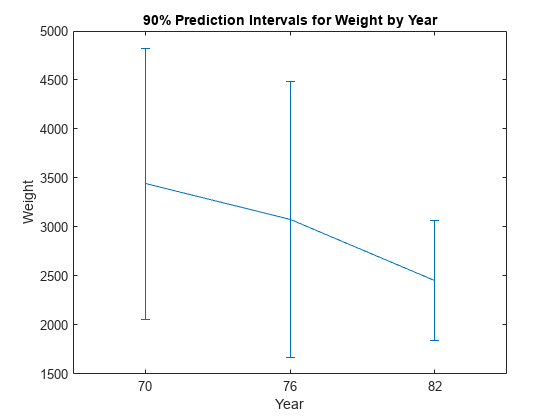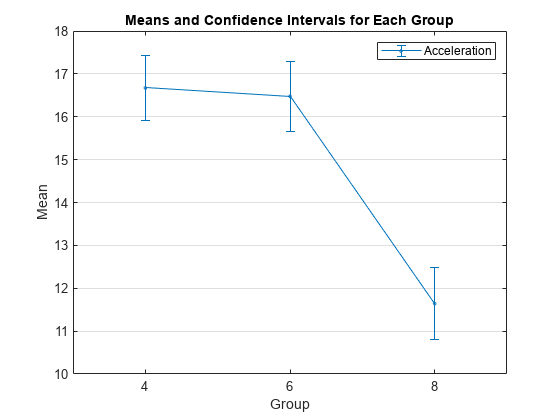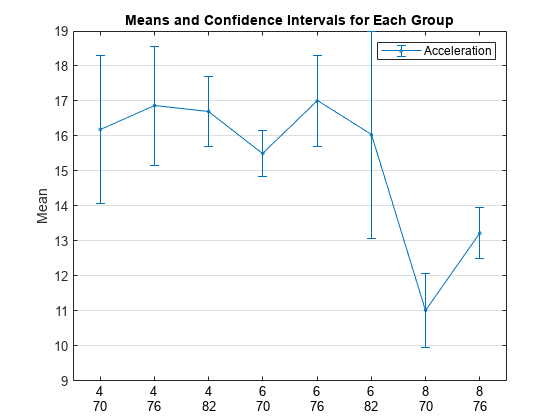grpstats
Summary statistics organized by group
Syntax
Description
tblstats = grpstats(tbl,groupvars)tbl, where the function determines the groups according
to the grouping variables in tbl specified by
groupvars.
If all variables in tbl (other than the grouping
variables) are numeric or logical, then the summary statistic is the mean of
each group for each variable in tbl. Otherwise, the summary
statistic is the number of elements in each group. tblstats
contains a row for each observed unique value or combination of values in the
grouping variables.
tblstats = grpstats(tbl,groupvars,whichstats)whichstats.
tblstats = grpstats(tbl,groupvars,whichstats,Name,Value)"DataVars",[2,4] instructs the function to compute
summary statistics for the second and fourth variables in
tbl.
stats = grpstats(X,group)X, where the function determines the groups by the
grouping variables in group.
If X is a numeric or logical matrix, then the summary
statistic is the mean of each group for each column of X.
Otherwise, the summary statistic is the number of elements in each group.
stats contains a row for each observed unique
combination of the grouping variables.
[
specifies the summary statistic types stats1,...,statsN] = grpstats(X,group,whichstats)whichstats and
returns an array for each summary statistic.
[
also specifies the significance level stats1,...,statsN] = grpstats(X,group,whichstats,"Alpha",a)a for confidence and
prediction intervals.
grpstats(
plots the group means of data in the numeric or logical matrix
X,group,alpha)X, grouped by the variables in
group. The function also plots the 100×(1 –
alpha)% confidence interval for each group mean. The
grouping variable values are on the horizontal plot axis.
If
Xis a matrix, thengrpstatsplots the means and confidence intervals for each column ofX.If
groupis a cell array of grouping variables, thengrpstatsplots the means and confidence intervals for the groups determined by the observed unique combinations of the grouping variables.
Examples
Input Arguments
Name-Value Arguments
Output Arguments
Algorithms
grpstatscomputes summary statistic values for each observed unique value or combination of values in the grouping variables.If you specify a single grouping variable, then the output of
grpstatscontains a row for each observed unique value of the grouping variable.grpstatssorts the groups by order of appearance (if the grouping variable is a character vector or string scalar); in ascending numeric order (if the grouping variable is numeric); or in order of by category (if the grouping variable is categorical).If you specify multiple grouping variables, then the output of
grpstatscontains a row for each observed unique combination of values in the grouping variables. For example, if you specify two grouping variables, each with two values, then the output has four possible combinations of grouping variable values. The function computes summary statistics only for the observed combinations that exist in the input grouping variables (not all possible combinations).grpstatssorts the groups by the values of the first grouping variable, then the second grouping variable, and so on.
grpstatsignores missing values intbl,X, andgroup. Missing values depend on the data type:NaNfordouble,single,duration, andcalendarDurationNaTfordatetime<missing>forstring<undefined>forcategorical' 'forchar{''}forcellof character vectors
Alternative Functionality
MATLAB® includes the function groupsummary, which also returns group summaries and is recommended when
you are working with a table. groupsummary allows you to specify
whether to include groups that consist of missing values and groups with zero elements
in the output. Also, the function supports various group binning schemes and anonymous
functions that require more than one input argument for custom summary
statistics.
Extended Capabilities
Version History
Introduced before R2006a



